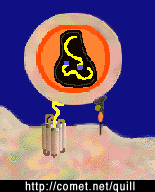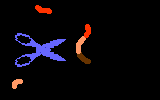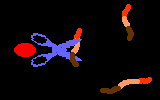 1.Attachment
and Entry
1.Attachment
and Entry 1.Attachment
and Entry
1.Attachment
and Entry The
Human Immunodeficiency Virus (HIV) attaches to the surface of the lymphocyte
(T-cell) membrane. HIV needs to bind to two different receptors. The primary
receptor is called CD4 and the second receptor is a transmembrane protein
that loops through the cell membrane of the T-cell seven times. The ligand,
in this case HIV, has to bind to both receptors in order for infection
to take place.
The
Human Immunodeficiency Virus (HIV) attaches to the surface of the lymphocyte
(T-cell) membrane. HIV needs to bind to two different receptors. The primary
receptor is called CD4 and the second receptor is a transmembrane protein
that loops through the cell membrane of the T-cell seven times. The ligand,
in this case HIV, has to bind to both receptors in order for infection
to take place.
 Once
the virus attaches itself to the two receptors, the two membranes fuse.
HIV viral DNA and the contents are empties into the host cell. HIV takes
over and makes many copies of itself.
Once
the virus attaches itself to the two receptors, the two membranes fuse.
HIV viral DNA and the contents are empties into the host cell. HIV takes
over and makes many copies of itself.
For more information on reverse transciption and it's inhibitors click on Dave.
 The
DNA made by the reverse transciptase from viral DNA is incorporated into
the host or T-cell's DNA. The enzyme called integrase helps insert the
viral DNA into the host. Once the viral DNA is part of the host's DNA it
is called provirus.
The
DNA made by the reverse transciptase from viral DNA is incorporated into
the host or T-cell's DNA. The enzyme called integrase helps insert the
viral DNA into the host. Once the viral DNA is part of the host's DNA it
is called provirus.
 If
the T-cell is active, transcription of the provirus (viral DNA) occurs.
Many copies of viral RNA are made. The viral RNA codes for viral proteins
and enzymes.
If
the T-cell is active, transcription of the provirus (viral DNA) occurs.
Many copies of viral RNA are made. The viral RNA codes for viral proteins
and enzymes. There
are nine genes in the HIV RNA. These genes have all the necessary codes
to make structural (viral envelope and core) proteins and enzymes (reverse
transcriptase, integrase, and protease).
There
are nine genes in the HIV RNA. These genes have all the necessary codes
to make structural (viral envelope and core) proteins and enzymes (reverse
transcriptase, integrase, and protease). The translated viral RNA is made into a long polypeptide sequence which
is made up of several individual proteins. These sections must be cut from
the long polypetptide chain in order for the proteins (enzymes) to be functional.
Viral protease acts as "chemical scissors" and cuts the chain
into the components.
The translated viral RNA is made into a long polypeptide sequence which
is made up of several individual proteins. These sections must be cut from
the long polypetptide chain in order for the proteins (enzymes) to be functional.
Viral protease acts as "chemical scissors" and cuts the chain
into the components. Protease
inhibitors are used fight HIV. It blocks the ability of the proteas to
cut the viral polypeptide into working enzymes. However, protease inhibitors
are not a cure fo AIDS. HIV may become resistent to any protease inhibitor.
Thus, the use of multiple drug therapy including reverse transcriptase
inhibitors is becoming popular.
Protease
inhibitors are used fight HIV. It blocks the ability of the proteas to
cut the viral polypeptide into working enzymes. However, protease inhibitors
are not a cure fo AIDS. HIV may become resistent to any protease inhibitor.
Thus, the use of multiple drug therapy including reverse transcriptase
inhibitors is becoming popular.
 Finally
the viral RNA proteins made are packaged and released from the host (T-cell).
The newly formed viruses take a lot of the T-cell membrane containing viral
surface proteins and these proteins bind to receptors on other immune cells.
Finally
the viral RNA proteins made are packaged and released from the host (T-cell).
The newly formed viruses take a lot of the T-cell membrane containing viral
surface proteins and these proteins bind to receptors on other immune cells.